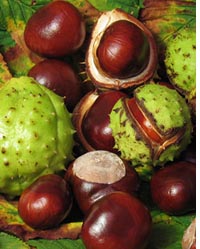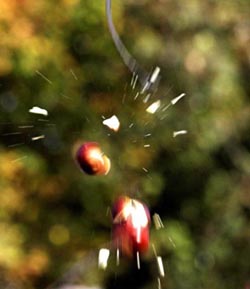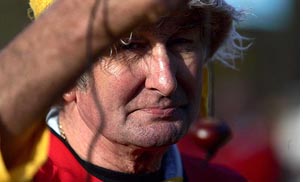Hail the Conkering Hero
by Jonathan Winspear
 The 2nd Sunday in October is the traditional date for the World Conker Championships. Combatants will gather in the village of Ashton, Northamptonshire, and fight for the coveted prize. The Championships have been held annually since 1965, and over £200,000 has been raised for the Royal National Institute for the Blind. Originally the idea of some locals whose fishing trip was spoiled by bad weather; they decided instead to have a game of conkers.
The 2nd Sunday in October is the traditional date for the World Conker Championships. Combatants will gather in the village of Ashton, Northamptonshire, and fight for the coveted prize. The Championships have been held annually since 1965, and over £200,000 has been raised for the Royal National Institute for the Blind. Originally the idea of some locals whose fishing trip was spoiled by bad weather; they decided instead to have a game of conkers.
What on earth is conkers? Well, forget Superbowl and World Cup soccer. This is sport at its most fierce and brutal! Here is a brief introduction to this nationwide activity.
It's early autumn. The leaves of Britain's trees begin to turn, squirrels and other creatures are busy gathering for the coming winter, and small boys and girls -- and those who should know better -- gather beneath Horse Chestnut trees and hurl sticks skyward, hoping to dislodge a champion conker. And what is the point to all this autumnal activity? It's time for a game of conkers, of course -- time for glory and bruised knuckles, or maybe a crushing defeat and bruised knuckles.
The first recorded game occurred in the mid 19th Century, though it is certainly older than that. Horse Chestnut trees were introduced in the 1600s, and folklore suggests that before then, cobnuts and hazelnuts were used.
 A small hole is drilled through the body of the nut, through which is passed a piece of strong string -- traditionally a bootlace. The string is knotted to prevent the conker from escaping. The non-conker end of string is wrapped around index and middle finger and gripped by the thumb. The conker is held lightly by the free hand, the stringed end forward, as if holding a catapult or pinging a rubber band. The conker is swung overhand, like a medieval catapult, onto the opponent's conker. Whilst awaiting this hopefully well-aimed blow, the defender must keep his conker still, hanging vertically by its string. A tight grip must be maintained, as letting go will forfeit your turn. If a successful blow is struck, another may be taken. If the blow is missed, the defender may take a turn attacking. The conker with the highest score always attacks first. If each conker is untried, then the toss of a coin will decide.
A small hole is drilled through the body of the nut, through which is passed a piece of strong string -- traditionally a bootlace. The string is knotted to prevent the conker from escaping. The non-conker end of string is wrapped around index and middle finger and gripped by the thumb. The conker is held lightly by the free hand, the stringed end forward, as if holding a catapult or pinging a rubber band. The conker is swung overhand, like a medieval catapult, onto the opponent's conker. Whilst awaiting this hopefully well-aimed blow, the defender must keep his conker still, hanging vertically by its string. A tight grip must be maintained, as letting go will forfeit your turn. If a successful blow is struck, another may be taken. If the blow is missed, the defender may take a turn attacking. The conker with the highest score always attacks first. If each conker is untried, then the toss of a coin will decide.
The point to all this is simple: to smash your opponent's conker into smithereens. That's the easy bit; thereafter it gets a bit complicated and technical jargon will be used. An untested conker has no rating. If an untested conker beats another untested conker, it becomes a 'one-er'. If it beats another it becomes a 'two-er' and so on. If, however, a 'two-er' beats a 'three-er', for example, then the victor absorbs the loser's score too, becoming a fiver. Simple, eh?
Though not allowed at the World Championships, there are many supposedly foolproof ways to toughen up one's conkers, and school-kids have been employing them for a hundred years. An old favourite is gently pickling the nuts in a vinegar solution, usually for a week. Another is to bake them in an oven at a low heat.
The British Government cannot help itself when it comes to interfering with traditional and fun activities. Thus, many local governments have banned the playing of conkers from school grounds, fearing legal action from parents whose children have been hurt by these 'offensive weapons'. This madness is not all. In 2001, councillors from Norwich, Norfolk, actually cut down several ancient Horse Chestnuts so that children throwing sticks into the branches would not injure themselves from the falling debris.
 More Information:
More Information:
We regret that we no longer have the resources to maintain up-to-date links and/or hours and pricing details for the various sites and attractions listed on this website. For more information about the location(s) listed above, please use your favorite search engine or visit Wikipedia.
Jonathan Winspear lives with his wife and two sons in the town of Benfleet, Essex, SE England. He works full time for HM Customs and Excise, a branch of the civil service dealing with revenue collection and the prevention of smuggling. His real passion is for writing, particularly local history and folklore. At all times he is inspired by the memory of his aunt, Violet Winspear, who wrote romantic fiction for Mills and Boon (Harlequin).
Article © 2005 Jonathan Winspear
Top photo © Andrew Dunn; provided courtesy of Wikipedia.com. Additional photos courtesy of World Conker Championships
|
